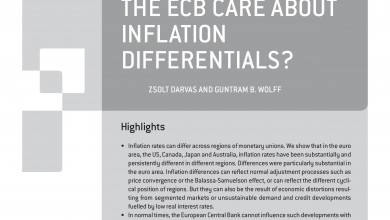The ECB announced today an expansion of its asset purchases, to include securities issued by European agencies and institutions, as well as central government in the euro area. Purchases are intended to be continued until at least September 2016 and in any case until the Governing Council sees a sustained adjustment in the path of inflation that is consistent with its aim of achieving inflation rates below, but close to, 2% over the medium term. This is a positive feature of the announcement, as it leaves the operation open ended enough.
The combined target monthly asset purchases will amount to 60 billion euro. However, this will also include the purchases already envisioned under the ABSPP and CBPP. There are no weekly targets for purchases under these two programmes, but the ECB had bought about 35bn combined as of 16 January. The CB purchases began in October and ABS purchases in November 2014, meaning the ECB bought on average around 10 billion a month. Assuming a similar pace in the future, the additional purchases would be around 50 billion (and not 60) per month, leading to a total of 900/950 billion under the scenario in which the programme were to be stopped in September 2016. This is still positively above the 500-700 billion range that had been rumoured ahead of the meeting.The maturity spectrum will also be very large, as eligible securities will range form a minimum remaining maturity of 2 years to a maximum remaining maturity of 30 years at the time of purchase.
The purchases will be pari passu with private investors, which will be achieved by imposing a 33% issuer limit and a 25% issue limit (the latter needed to help avoid that the ECB achieves a blocking stake under Collective Action Clauses (CACs)).
The most interesting point, as largely expected, is the risk sharing arrangement of the programme. Purchases of securities of European institutions (which will account for 12% of the additional asset purchases, and which will be purchased by NCBs) will be subject to loss sharing. This is consistent with the idea that these securities are at present the closest resemblant to an Euro/EU-wide bond, as we first pointed out in May. On top of this, the ECB will hold 8% of the additional asset purchases, meaning that a total 20% of the purchases will be subject to loss sharing. The rest of the NCBs’ additional asset purchases will however not be subject to loss sharing at all. This effectively means that 80% of the risk is borne by the NCBs, and fragmented along national borders. However, if we consider only the purchases of non-EU-wide securities (i.e. if we exclude that 12% of the purchases that are likely to be safest), then only 9% of the national sovereign risk will be shared.
- Overall, the large majority of the governing council came to the correct assessment that inflation expectations are getting disanchored and that therefore monetary policy action was needed.
- The programme is large. This increases its effectiveness and will have a powerful impact especially through the exchange rate channel and the portfolio rebalancing channel
- Some Northern governing council members were concerned that such a large programme would mean that the ECB takes on board a too significant fiscal risk. The ECB therefore reduced risk sharing substantially. This may reduce the effectiveness of the programme.
- Before this decision, nobody could have questioned whether monetary policy is “single”. Now, investors can rightly ask that question. Mario Draghi addressed this several times in his comments but his answers were not convincing. This question will be an important issue in the coming months and potentially years.


